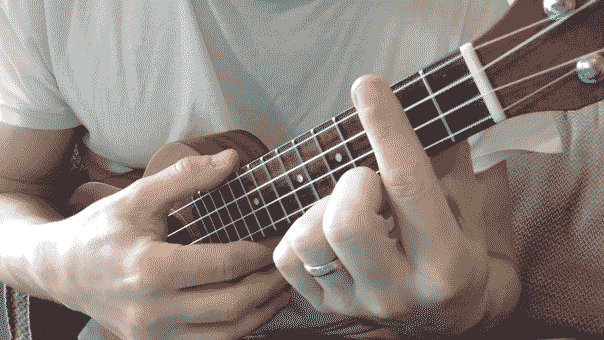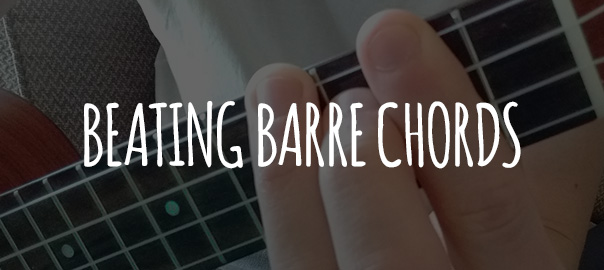If you’ve landed on this page there’s a good chance that you’re struggling with playing barre chords on your ukulele. Let me start by saying that you’re not alone. At one time or other every player has battled against barre chords. The good news is that there’s a way through it. Here are some tips to help you on your way…
What Is a Barre Chord?
A barre chord involves you using a single finger to fret all the strings at once. There are no open strings involved in barre chords so one of your fingers (usually your index) ends up acting like the nut of your ukulele. For newcomers they’re difficult to play to begin with because they require a combination of finger strength and dexterity that hasn’t yet been developed.
 How To Play A Barre Chord
How To Play A Barre Chord
Take a look at the diagram opposite, it shows a chord box (help with chord boxes here) for a B minor chord. To play this chord you’ll need to lay your index finger across the second fret and press quite hard (so that it actually squeezes down every string). On top of this you’ll need to fret the other note using your third finger.
Essentially your index finger is now acting as the nut of the ukulele and you’ve just created a moveable chord shape.
One Finger At A Time
To begin with, if you’ve never played a barre chord before we’re going to take this one finger at a time. We’ll start with the finger that most people struggle with – the index finger. Let’s start by laying your index finger across fret 2. Try and get your thumb directly behind your index finger on the neck – you’ll need to use it as support.
Strum down slowly across the strings and make sure that each string sounds clear and that there are no muted notes. If you are hearing a muted note somewhere then there’s a good chance that you’re not putting enough pressure on the fret.

I’d recommend just working with your index finger initially and barring at various frets. Get your hand used to squeezing the barre down – to begin with stay below fret 5 (it gets a bit cramped further up the neck). You can see on the image above that I’m alternating between barring at fret 2 and 3, you can mix it up a little more though.
Rotate For Extra Strength
Rather than squeezing harder which will soon tire your finger out what I want you to do is to rotate your barring finger back towards the nut very slightly. This puts your finger in a much stronger position and requires less pressure to actually make a string connection. Notice the slight rotation on the image below after I lay my finger on the second fret.

With your first finger now barring a fret give it a strum and then ease back off the pressure a little bit. Keep your fingers in position but let them relax. When your finger is relaxed again, squeeze and give it another strum.
Little By Little
When you first start learning barre chords you’re going to be putting your index finger through a crazy workout. It will tire quickly and cramp up and basically do all it can to end your barre chord career as early as possible.
What you need to do is squeeze for the minimum amount of time possible. You only need to hold the squeeze for the duration that you want the chord to last. Any more and it’s wasted effort.
Every Day
One more tip that I would fully recommend doing is committing to practising your barre chords every day. Practise for 5 minutes on barre chords a day and you’ll master them in no time at all. If you’re looking for a song to practise barre chords on I’d recommend giving Creep by Radiohead a try!
Hopefully these tips will help you on your way to master barre chords!





Good scoops!
Rotating, practicing with 6th chords, and putting the thumb behind are good tips. Another one is not pressing too hard – I see people hurting themselves with bar chords, and even pressing so hard they bend the whole chord out of tune.
That’s a great tip Karl, a lot of beginners press down so hard their knuckles turn white!
Good advice! The little rotation helps a lot. Also having lower action Really Really helps!
Okay, I’m great with the straight barred chords and the Bm type shapes, but I’m really having a tough time with barred chords with these shapes (anywhere on the neck): 2-3-3-3 and 3-5-5-5. I’ve tried to cover the entire barre for the “first” note (closest to the neck), but neither my “tall man”finger or ring finger are able to capture their three notes cleanly. Practice, I know, but any tips at all? And, no, I don’t really want to use my thumb for the G string… Perhaps using more than one finger for the CEA strings, not just a single finger? But that’s pretty tough, too…
P.S. I typically suggest beginners start with barred chords at, say, the fifth fret and, during practice, move up to the first; there’s less string “pressure” required at the fifth than up by the nut and they can hear and feel the success easier…But not too much pressure–as they say, “jus’ press.”
Hey Tonya, I’m really sorry I missed this comment but if you’re still out there here’s a few ideas…
For a shape that is something like 2-3-3-3 which I believe is a Cm6 – you could play it using all 4 fingers and it’s not too difficult. Essentially you’d be using your first finger for the G string, 2nd finger for the C and so on. It will still take some practice to get this right but it’s certainly doable and isn’t quite as demanding from a finger strength point of view.
The same principle applies when there’s a clear fret between the shape too (like your 3-5-5-5 example A#maj7) but it gets a little bit more demanding on the fingers.
Hope that helps
do these bar chords work for banjo uke
Hey Dick, yeah they will work (assuming your banjo uke is tuned to C)
I have hit a Bar! I don’t get how you leave some strings out on the bar chords with the index finger aa in put the index finger on string 2 and four and the you have to use fingers 23 and four stretched in shapes.. I feel like I will never be able to do it!
Hi Jo,
Try this out. Fret an F chord but instead of using your first and second fingers use your second and third. This will leave your index finger free. Slide that F chord up by a single fret. Your index finger is now free to lay across the first fret in it’s entirety and barre across. Does that help?
I’m going to try rotating my index finger when t practice my barre chords tomorrow. I find them very difficult. I’m working on strenghtibg my index finger…flattening it over several buttons and pushing it down on my finger master. I’m not sure it will help but I have to try something! Thanks for the tips!
Very clear lessons and the commentary is perfect. Great topics as well. . .
Much appreciate the time you have spent to share your talent.
Which side of the fret should one bar? When I bar the second fret my finger is barring on top of the 2nd fret. The picture shows your finger back against the 1st fret. Hope I’m making sense here.
Thanks.
You should bar behind but as close to the fret as you can. You’ll know when you’ve gone too far as it will deaden the sound.
Dave, I think she’s asking why you rotate towards the nut – isn’t the 2nd fret the one nearer the other end of uke? Sorry, I too wondered about that.
To explain if anyone is still reading…
When you bar at the second fret, there will be only one fret between your finger and the nut – as shown in the photo.
Hope that helps.